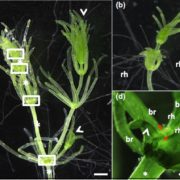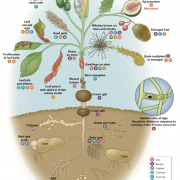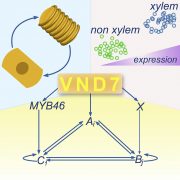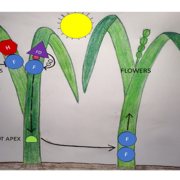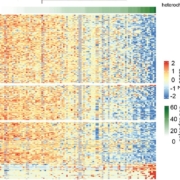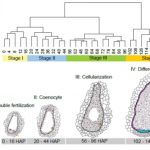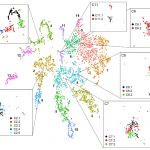Control of proliferation in the haploid meristem by CLE peptide signaling in Marchantia polymorpha (PLOS Genetics)
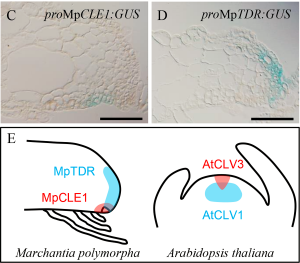 The peptide/hormones CLE (CLAVATA3/EMBRYO SURROUNDING REGION-related) and their receptors are a fascinating cell signal system that regulates meristems activity in angiosperms and is crucial for the establishment of 3D forms. How this system works in bryophytes is very relevant to understand its evolution in plants that develop different body plans. Differently to the moss Physcomitrella patens that possess a single CLE peptide similar to CLV3 type, the liverwort Marchantia polymorpha genome harbors a single copy of both known types (CLV3 and TDIF). Here, Hirakawa et al. provide an exhaustive characterization of the TDIF type peptide MpCLE1 in M. polymorpha. With a few amino acid changes, MpCLE1 can mimic the effect of the homolog AtCLE41 in Arabidopsis. Despite that, mutant and overexpressing plants of MpCLE1 and the receptor, MpTDR, suggest that they work as negative regulators of meristem activity, similar to CLV-type but the opposite function described for TDIF-type peptides in angiosperm.On the other hand, MpCLE1 loss-of-function resembles the abnormal cell division planes phenotype in TDIF gain and loss-of-function in Arabidopsis. Its function seems to be a combination of both CLE peptides types in angiosperms, showing the complex evolution pattern of this signaling system in land plants. (Summary by Facundo Romani) PLOS Genetics 10.1371/journal.pgen.1007997
The peptide/hormones CLE (CLAVATA3/EMBRYO SURROUNDING REGION-related) and their receptors are a fascinating cell signal system that regulates meristems activity in angiosperms and is crucial for the establishment of 3D forms. How this system works in bryophytes is very relevant to understand its evolution in plants that develop different body plans. Differently to the moss Physcomitrella patens that possess a single CLE peptide similar to CLV3 type, the liverwort Marchantia polymorpha genome harbors a single copy of both known types (CLV3 and TDIF). Here, Hirakawa et al. provide an exhaustive characterization of the TDIF type peptide MpCLE1 in M. polymorpha. With a few amino acid changes, MpCLE1 can mimic the effect of the homolog AtCLE41 in Arabidopsis. Despite that, mutant and overexpressing plants of MpCLE1 and the receptor, MpTDR, suggest that they work as negative regulators of meristem activity, similar to CLV-type but the opposite function described for TDIF-type peptides in angiosperm.On the other hand, MpCLE1 loss-of-function resembles the abnormal cell division planes phenotype in TDIF gain and loss-of-function in Arabidopsis. Its function seems to be a combination of both CLE peptides types in angiosperms, showing the complex evolution pattern of this signaling system in land plants. (Summary by Facundo Romani) PLOS Genetics 10.1371/journal.pgen.1007997


